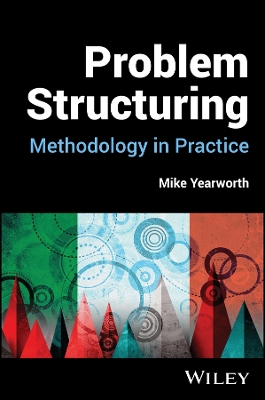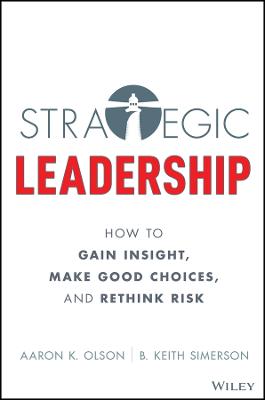Problem Structuring
 -15%
portes grátis
-15%
portes grátis
Problem Structuring
Methodology in Practice
Yearworth, Mike
John Wiley & Sons Inc
09/2024
368
Dura
Inglês
9781119744825
15 a 20 dias
Descrição não disponível.
Preface xiii
Acknowledgements xxi
Glossary xxv
Section I The Problem of Problem Formulation 1
1 Origins 3
1.1 Why Methodology? 3
1.2 Why Not Problem-solving? 4
1.3 From Puzzles, Problems, to Messes 7
1.4 The Apparent Success of Operational Research 10
1.5 The Process of Problematisation 11
1.6 Problem Structuring Methods 13
1.7 Summary 15
2 Wicked and Messy Problems 17
2.1 On Dichotomies 17
2.2 Wicked and Tame 18
2.3 Swamps and High Ground 22
2.4 Problems and Messes 24
2.5 An Ontological Viewpoint 25
2.5.1 Cynefin 26
2.5.2 Wickedness and Anatomy of Complexity 26
2.5.3 The System of Systems Methodologies 28
2.6 The Burrell and Morgan Framework 29
2.7 Category Mistakes and Paradigm Incommensurability 31
3 A Pragmatic Framing 33
3.1 Dichotomies, Again 33
3.2 Organised Finding Out 35
3.3 Action Is Knowledge 41
3.4 Ways Forward 42
Section II Problem Structuring Methods 45
4 The Emergence of PSMs - A History 47
4.1 The Critique of the Mainstream OR Phase: Emergence of a New Paradigm 49
4.2 The Methodological Phase: Emergence of Core Methodologies 53
4.3 First Reflective Period 57
4.4 Summary 58
5 Comparison of Core Methods 61
5.1 Analysis of the Three Core Techniques 61
5.2 Constitutive Rules 64
5.3 Epistemologies 66
5.4 Comparative Affordances of Modelling Approaches 70
5.5 A Processual Analysis of Modelling in the Core Methodologies 76
5.5.1 SSM 76
5.5.2 SODA Project 79
5.5.3 SCA 83
5.6 Summary of Core Modelling Approaches 86
5.7 The Influence of Computer-supported Modelling 87
5.8 Related Approaches 87
5.8.1 IBIS 87
5.8.2 Causal Loop Diagrams 88
5.9 Conclusion 93
6 The Practice of Problem Structuring 95
6.1 Recap 95
6.2 Establishing a Trust Relationship 97
6.3 Dealing with the Value Paradox 99
6.4 Identifying Relevant Stakeholders and Dealing with Multi-organisational Contexts 103
6.5 Being Ready to Facilitate 106
6.6 Ethical Practice 109
6.7 Relation to the Wider PSM Field 109
6.8 Summary 110
6.9 State of the Art 112
Section III Problem Structuring in Engineering Practice 113
7 Developing a Problem Structuring Sensibility in Engineering 115
7.1 Introduction 115
7.2 From Systems Engineering to Soft Systems Methodology - and Back Again 116
7.3 Philosophy of Engineering 121
7.4 A New Definition of Soft Systems for Engineers 122
7.5 Systems Engineering in the Context of Systemic Cooperation 124
7.6 Conclusions 128
8 On the Theoretical Foundations of Systems Engineering 131
9 Hierarchical Process Modelling 135
9.1 Motivation 135
9.2 Origins 136
9.3 What Is HPM as a PSM? 138
9.3.1 Process Epistemology 139
9.3.2 Modelling Purpose 140
9.3.3 How/Why Modelling Dialectic 141
9.3.4 Measuring Process Performance with Explicit Representation of Uncertainty 142
9.3.5 Argumentation 148
9.4 Epistemology for HPM 148
9.5 The Affordance of the HPM Approach 150
9.6 Assembling into a Methodology 153
10 Practical Aspects for Using HPM as a PSM 155
10.1 Case Study I -STEEP and REPLICATE Projects 155
10.2 Updating the Tool Support for the Modelling Approach 159
10.3 Teaching Example I - 'SuperCo' 162
10.4 Teaching Example II - Servitisation and the Circular Economy 167
10.5 Teaching Example III - Heritage Railway MEng Consulting Project 167
10.6 Case Study II - 'Continuous Process Manufacturing Company' 169
10.7 Case Study III - Healthy Resilient Cities 171
10.7.1 Workshop 175
10.7.2 Key Findings from the Project 179
10.7.3 Selling the Approach as a Commercial Service 180
10.7.4 Infrastructure Interdependency 181
10.8 Conclusions 182
11 Problem Structuring in Engineering Practice 185
11.1 Introduction 186
11.2 Anticipation, Injunctions and Translations 186
11.3 Widening Participation and Broadening the Scope 188
11.4 Moving Away from Singular Outcomes 190
11.5 Working with Multiple Viewpoints 190
11.6 Being Aware of Conceptual Limitations 191
11.7 Valuing Process Knowledge 191
Section IV Evolution 195
12 Evaluation 197
12.1 Why Wait Until Now? 197
13 Survey of PSM Applications 203
13.1 Introduction 203
13.2 Method of Selection 203
13.3 Classification of PSM Applications 206
13.4 Survey of PSM Applications by Subject Area 206
13.5 Observations 212
13.6 Interdisciplinarity 214
13.7 Other Traditions 217
13.8 Conclusions 218
14 Digital Transformation Through Group Support Systems (gss) 221
14.1 Motivation 221
14.2 Experimental Setting 223
14.3 Teaching Requirements 225
14.4 Reflections 230
14.5 The Effectiveness of Online Problem Structuring Practice 232
14.6 Teaching of PSMs in an Education Setting 234
14.7 Extension to Large Group Working 235
15 New Technologies for Augmenting PSM Practice 239
15.1 Augmented Qualitative Analysis (AQA) 239
15.2 PSMs in the Age of LLMs 244
15.3 Future Directions 251
16 Setting the Agenda 253
16.1 Building Links 254
16.1.1 Towards New Disciplinary Partners in Applied Social Science 254
16.1.2 Towards Mainstream OR 257
16.2 Education 264
16.3 Introducing a Processual Turn in OR 268
Grant and Project Funding 271
Selected Bookshelf 273
References 275
Index 317
Acknowledgements xxi
Glossary xxv
Section I The Problem of Problem Formulation 1
1 Origins 3
1.1 Why Methodology? 3
1.2 Why Not Problem-solving? 4
1.3 From Puzzles, Problems, to Messes 7
1.4 The Apparent Success of Operational Research 10
1.5 The Process of Problematisation 11
1.6 Problem Structuring Methods 13
1.7 Summary 15
2 Wicked and Messy Problems 17
2.1 On Dichotomies 17
2.2 Wicked and Tame 18
2.3 Swamps and High Ground 22
2.4 Problems and Messes 24
2.5 An Ontological Viewpoint 25
2.5.1 Cynefin 26
2.5.2 Wickedness and Anatomy of Complexity 26
2.5.3 The System of Systems Methodologies 28
2.6 The Burrell and Morgan Framework 29
2.7 Category Mistakes and Paradigm Incommensurability 31
3 A Pragmatic Framing 33
3.1 Dichotomies, Again 33
3.2 Organised Finding Out 35
3.3 Action Is Knowledge 41
3.4 Ways Forward 42
Section II Problem Structuring Methods 45
4 The Emergence of PSMs - A History 47
4.1 The Critique of the Mainstream OR Phase: Emergence of a New Paradigm 49
4.2 The Methodological Phase: Emergence of Core Methodologies 53
4.3 First Reflective Period 57
4.4 Summary 58
5 Comparison of Core Methods 61
5.1 Analysis of the Three Core Techniques 61
5.2 Constitutive Rules 64
5.3 Epistemologies 66
5.4 Comparative Affordances of Modelling Approaches 70
5.5 A Processual Analysis of Modelling in the Core Methodologies 76
5.5.1 SSM 76
5.5.2 SODA Project 79
5.5.3 SCA 83
5.6 Summary of Core Modelling Approaches 86
5.7 The Influence of Computer-supported Modelling 87
5.8 Related Approaches 87
5.8.1 IBIS 87
5.8.2 Causal Loop Diagrams 88
5.9 Conclusion 93
6 The Practice of Problem Structuring 95
6.1 Recap 95
6.2 Establishing a Trust Relationship 97
6.3 Dealing with the Value Paradox 99
6.4 Identifying Relevant Stakeholders and Dealing with Multi-organisational Contexts 103
6.5 Being Ready to Facilitate 106
6.6 Ethical Practice 109
6.7 Relation to the Wider PSM Field 109
6.8 Summary 110
6.9 State of the Art 112
Section III Problem Structuring in Engineering Practice 113
7 Developing a Problem Structuring Sensibility in Engineering 115
7.1 Introduction 115
7.2 From Systems Engineering to Soft Systems Methodology - and Back Again 116
7.3 Philosophy of Engineering 121
7.4 A New Definition of Soft Systems for Engineers 122
7.5 Systems Engineering in the Context of Systemic Cooperation 124
7.6 Conclusions 128
8 On the Theoretical Foundations of Systems Engineering 131
9 Hierarchical Process Modelling 135
9.1 Motivation 135
9.2 Origins 136
9.3 What Is HPM as a PSM? 138
9.3.1 Process Epistemology 139
9.3.2 Modelling Purpose 140
9.3.3 How/Why Modelling Dialectic 141
9.3.4 Measuring Process Performance with Explicit Representation of Uncertainty 142
9.3.5 Argumentation 148
9.4 Epistemology for HPM 148
9.5 The Affordance of the HPM Approach 150
9.6 Assembling into a Methodology 153
10 Practical Aspects for Using HPM as a PSM 155
10.1 Case Study I -STEEP and REPLICATE Projects 155
10.2 Updating the Tool Support for the Modelling Approach 159
10.3 Teaching Example I - 'SuperCo' 162
10.4 Teaching Example II - Servitisation and the Circular Economy 167
10.5 Teaching Example III - Heritage Railway MEng Consulting Project 167
10.6 Case Study II - 'Continuous Process Manufacturing Company' 169
10.7 Case Study III - Healthy Resilient Cities 171
10.7.1 Workshop 175
10.7.2 Key Findings from the Project 179
10.7.3 Selling the Approach as a Commercial Service 180
10.7.4 Infrastructure Interdependency 181
10.8 Conclusions 182
11 Problem Structuring in Engineering Practice 185
11.1 Introduction 186
11.2 Anticipation, Injunctions and Translations 186
11.3 Widening Participation and Broadening the Scope 188
11.4 Moving Away from Singular Outcomes 190
11.5 Working with Multiple Viewpoints 190
11.6 Being Aware of Conceptual Limitations 191
11.7 Valuing Process Knowledge 191
Section IV Evolution 195
12 Evaluation 197
12.1 Why Wait Until Now? 197
13 Survey of PSM Applications 203
13.1 Introduction 203
13.2 Method of Selection 203
13.3 Classification of PSM Applications 206
13.4 Survey of PSM Applications by Subject Area 206
13.5 Observations 212
13.6 Interdisciplinarity 214
13.7 Other Traditions 217
13.8 Conclusions 218
14 Digital Transformation Through Group Support Systems (gss) 221
14.1 Motivation 221
14.2 Experimental Setting 223
14.3 Teaching Requirements 225
14.4 Reflections 230
14.5 The Effectiveness of Online Problem Structuring Practice 232
14.6 Teaching of PSMs in an Education Setting 234
14.7 Extension to Large Group Working 235
15 New Technologies for Augmenting PSM Practice 239
15.1 Augmented Qualitative Analysis (AQA) 239
15.2 PSMs in the Age of LLMs 244
15.3 Future Directions 251
16 Setting the Agenda 253
16.1 Building Links 254
16.1.1 Towards New Disciplinary Partners in Applied Social Science 254
16.1.2 Towards Mainstream OR 257
16.2 Education 264
16.3 Introducing a Processual Turn in OR 268
Grant and Project Funding 271
Selected Bookshelf 273
References 275
Index 317
Este título pertence ao(s) assunto(s) indicados(s). Para ver outros títulos clique no assunto desejado.
operational research; problem structuring; problem structuring methods; the practice of operational research; complex systems; wicked problems; soft systems methodology; soft operational research; systems engineering; engineering systems; engineering ethics; engineering practice; systems thinking; hierarchical process modelling; group support systems
Preface xiii
Acknowledgements xxi
Glossary xxv
Section I The Problem of Problem Formulation 1
1 Origins 3
1.1 Why Methodology? 3
1.2 Why Not Problem-solving? 4
1.3 From Puzzles, Problems, to Messes 7
1.4 The Apparent Success of Operational Research 10
1.5 The Process of Problematisation 11
1.6 Problem Structuring Methods 13
1.7 Summary 15
2 Wicked and Messy Problems 17
2.1 On Dichotomies 17
2.2 Wicked and Tame 18
2.3 Swamps and High Ground 22
2.4 Problems and Messes 24
2.5 An Ontological Viewpoint 25
2.5.1 Cynefin 26
2.5.2 Wickedness and Anatomy of Complexity 26
2.5.3 The System of Systems Methodologies 28
2.6 The Burrell and Morgan Framework 29
2.7 Category Mistakes and Paradigm Incommensurability 31
3 A Pragmatic Framing 33
3.1 Dichotomies, Again 33
3.2 Organised Finding Out 35
3.3 Action Is Knowledge 41
3.4 Ways Forward 42
Section II Problem Structuring Methods 45
4 The Emergence of PSMs - A History 47
4.1 The Critique of the Mainstream OR Phase: Emergence of a New Paradigm 49
4.2 The Methodological Phase: Emergence of Core Methodologies 53
4.3 First Reflective Period 57
4.4 Summary 58
5 Comparison of Core Methods 61
5.1 Analysis of the Three Core Techniques 61
5.2 Constitutive Rules 64
5.3 Epistemologies 66
5.4 Comparative Affordances of Modelling Approaches 70
5.5 A Processual Analysis of Modelling in the Core Methodologies 76
5.5.1 SSM 76
5.5.2 SODA Project 79
5.5.3 SCA 83
5.6 Summary of Core Modelling Approaches 86
5.7 The Influence of Computer-supported Modelling 87
5.8 Related Approaches 87
5.8.1 IBIS 87
5.8.2 Causal Loop Diagrams 88
5.9 Conclusion 93
6 The Practice of Problem Structuring 95
6.1 Recap 95
6.2 Establishing a Trust Relationship 97
6.3 Dealing with the Value Paradox 99
6.4 Identifying Relevant Stakeholders and Dealing with Multi-organisational Contexts 103
6.5 Being Ready to Facilitate 106
6.6 Ethical Practice 109
6.7 Relation to the Wider PSM Field 109
6.8 Summary 110
6.9 State of the Art 112
Section III Problem Structuring in Engineering Practice 113
7 Developing a Problem Structuring Sensibility in Engineering 115
7.1 Introduction 115
7.2 From Systems Engineering to Soft Systems Methodology - and Back Again 116
7.3 Philosophy of Engineering 121
7.4 A New Definition of Soft Systems for Engineers 122
7.5 Systems Engineering in the Context of Systemic Cooperation 124
7.6 Conclusions 128
8 On the Theoretical Foundations of Systems Engineering 131
9 Hierarchical Process Modelling 135
9.1 Motivation 135
9.2 Origins 136
9.3 What Is HPM as a PSM? 138
9.3.1 Process Epistemology 139
9.3.2 Modelling Purpose 140
9.3.3 How/Why Modelling Dialectic 141
9.3.4 Measuring Process Performance with Explicit Representation of Uncertainty 142
9.3.5 Argumentation 148
9.4 Epistemology for HPM 148
9.5 The Affordance of the HPM Approach 150
9.6 Assembling into a Methodology 153
10 Practical Aspects for Using HPM as a PSM 155
10.1 Case Study I -STEEP and REPLICATE Projects 155
10.2 Updating the Tool Support for the Modelling Approach 159
10.3 Teaching Example I - 'SuperCo' 162
10.4 Teaching Example II - Servitisation and the Circular Economy 167
10.5 Teaching Example III - Heritage Railway MEng Consulting Project 167
10.6 Case Study II - 'Continuous Process Manufacturing Company' 169
10.7 Case Study III - Healthy Resilient Cities 171
10.7.1 Workshop 175
10.7.2 Key Findings from the Project 179
10.7.3 Selling the Approach as a Commercial Service 180
10.7.4 Infrastructure Interdependency 181
10.8 Conclusions 182
11 Problem Structuring in Engineering Practice 185
11.1 Introduction 186
11.2 Anticipation, Injunctions and Translations 186
11.3 Widening Participation and Broadening the Scope 188
11.4 Moving Away from Singular Outcomes 190
11.5 Working with Multiple Viewpoints 190
11.6 Being Aware of Conceptual Limitations 191
11.7 Valuing Process Knowledge 191
Section IV Evolution 195
12 Evaluation 197
12.1 Why Wait Until Now? 197
13 Survey of PSM Applications 203
13.1 Introduction 203
13.2 Method of Selection 203
13.3 Classification of PSM Applications 206
13.4 Survey of PSM Applications by Subject Area 206
13.5 Observations 212
13.6 Interdisciplinarity 214
13.7 Other Traditions 217
13.8 Conclusions 218
14 Digital Transformation Through Group Support Systems (gss) 221
14.1 Motivation 221
14.2 Experimental Setting 223
14.3 Teaching Requirements 225
14.4 Reflections 230
14.5 The Effectiveness of Online Problem Structuring Practice 232
14.6 Teaching of PSMs in an Education Setting 234
14.7 Extension to Large Group Working 235
15 New Technologies for Augmenting PSM Practice 239
15.1 Augmented Qualitative Analysis (AQA) 239
15.2 PSMs in the Age of LLMs 244
15.3 Future Directions 251
16 Setting the Agenda 253
16.1 Building Links 254
16.1.1 Towards New Disciplinary Partners in Applied Social Science 254
16.1.2 Towards Mainstream OR 257
16.2 Education 264
16.3 Introducing a Processual Turn in OR 268
Grant and Project Funding 271
Selected Bookshelf 273
References 275
Index 317
Acknowledgements xxi
Glossary xxv
Section I The Problem of Problem Formulation 1
1 Origins 3
1.1 Why Methodology? 3
1.2 Why Not Problem-solving? 4
1.3 From Puzzles, Problems, to Messes 7
1.4 The Apparent Success of Operational Research 10
1.5 The Process of Problematisation 11
1.6 Problem Structuring Methods 13
1.7 Summary 15
2 Wicked and Messy Problems 17
2.1 On Dichotomies 17
2.2 Wicked and Tame 18
2.3 Swamps and High Ground 22
2.4 Problems and Messes 24
2.5 An Ontological Viewpoint 25
2.5.1 Cynefin 26
2.5.2 Wickedness and Anatomy of Complexity 26
2.5.3 The System of Systems Methodologies 28
2.6 The Burrell and Morgan Framework 29
2.7 Category Mistakes and Paradigm Incommensurability 31
3 A Pragmatic Framing 33
3.1 Dichotomies, Again 33
3.2 Organised Finding Out 35
3.3 Action Is Knowledge 41
3.4 Ways Forward 42
Section II Problem Structuring Methods 45
4 The Emergence of PSMs - A History 47
4.1 The Critique of the Mainstream OR Phase: Emergence of a New Paradigm 49
4.2 The Methodological Phase: Emergence of Core Methodologies 53
4.3 First Reflective Period 57
4.4 Summary 58
5 Comparison of Core Methods 61
5.1 Analysis of the Three Core Techniques 61
5.2 Constitutive Rules 64
5.3 Epistemologies 66
5.4 Comparative Affordances of Modelling Approaches 70
5.5 A Processual Analysis of Modelling in the Core Methodologies 76
5.5.1 SSM 76
5.5.2 SODA Project 79
5.5.3 SCA 83
5.6 Summary of Core Modelling Approaches 86
5.7 The Influence of Computer-supported Modelling 87
5.8 Related Approaches 87
5.8.1 IBIS 87
5.8.2 Causal Loop Diagrams 88
5.9 Conclusion 93
6 The Practice of Problem Structuring 95
6.1 Recap 95
6.2 Establishing a Trust Relationship 97
6.3 Dealing with the Value Paradox 99
6.4 Identifying Relevant Stakeholders and Dealing with Multi-organisational Contexts 103
6.5 Being Ready to Facilitate 106
6.6 Ethical Practice 109
6.7 Relation to the Wider PSM Field 109
6.8 Summary 110
6.9 State of the Art 112
Section III Problem Structuring in Engineering Practice 113
7 Developing a Problem Structuring Sensibility in Engineering 115
7.1 Introduction 115
7.2 From Systems Engineering to Soft Systems Methodology - and Back Again 116
7.3 Philosophy of Engineering 121
7.4 A New Definition of Soft Systems for Engineers 122
7.5 Systems Engineering in the Context of Systemic Cooperation 124
7.6 Conclusions 128
8 On the Theoretical Foundations of Systems Engineering 131
9 Hierarchical Process Modelling 135
9.1 Motivation 135
9.2 Origins 136
9.3 What Is HPM as a PSM? 138
9.3.1 Process Epistemology 139
9.3.2 Modelling Purpose 140
9.3.3 How/Why Modelling Dialectic 141
9.3.4 Measuring Process Performance with Explicit Representation of Uncertainty 142
9.3.5 Argumentation 148
9.4 Epistemology for HPM 148
9.5 The Affordance of the HPM Approach 150
9.6 Assembling into a Methodology 153
10 Practical Aspects for Using HPM as a PSM 155
10.1 Case Study I -STEEP and REPLICATE Projects 155
10.2 Updating the Tool Support for the Modelling Approach 159
10.3 Teaching Example I - 'SuperCo' 162
10.4 Teaching Example II - Servitisation and the Circular Economy 167
10.5 Teaching Example III - Heritage Railway MEng Consulting Project 167
10.6 Case Study II - 'Continuous Process Manufacturing Company' 169
10.7 Case Study III - Healthy Resilient Cities 171
10.7.1 Workshop 175
10.7.2 Key Findings from the Project 179
10.7.3 Selling the Approach as a Commercial Service 180
10.7.4 Infrastructure Interdependency 181
10.8 Conclusions 182
11 Problem Structuring in Engineering Practice 185
11.1 Introduction 186
11.2 Anticipation, Injunctions and Translations 186
11.3 Widening Participation and Broadening the Scope 188
11.4 Moving Away from Singular Outcomes 190
11.5 Working with Multiple Viewpoints 190
11.6 Being Aware of Conceptual Limitations 191
11.7 Valuing Process Knowledge 191
Section IV Evolution 195
12 Evaluation 197
12.1 Why Wait Until Now? 197
13 Survey of PSM Applications 203
13.1 Introduction 203
13.2 Method of Selection 203
13.3 Classification of PSM Applications 206
13.4 Survey of PSM Applications by Subject Area 206
13.5 Observations 212
13.6 Interdisciplinarity 214
13.7 Other Traditions 217
13.8 Conclusions 218
14 Digital Transformation Through Group Support Systems (gss) 221
14.1 Motivation 221
14.2 Experimental Setting 223
14.3 Teaching Requirements 225
14.4 Reflections 230
14.5 The Effectiveness of Online Problem Structuring Practice 232
14.6 Teaching of PSMs in an Education Setting 234
14.7 Extension to Large Group Working 235
15 New Technologies for Augmenting PSM Practice 239
15.1 Augmented Qualitative Analysis (AQA) 239
15.2 PSMs in the Age of LLMs 244
15.3 Future Directions 251
16 Setting the Agenda 253
16.1 Building Links 254
16.1.1 Towards New Disciplinary Partners in Applied Social Science 254
16.1.2 Towards Mainstream OR 257
16.2 Education 264
16.3 Introducing a Processual Turn in OR 268
Grant and Project Funding 271
Selected Bookshelf 273
References 275
Index 317
Este título pertence ao(s) assunto(s) indicados(s). Para ver outros títulos clique no assunto desejado.
operational research; problem structuring; problem structuring methods; the practice of operational research; complex systems; wicked problems; soft systems methodology; soft operational research; systems engineering; engineering systems; engineering ethics; engineering practice; systems thinking; hierarchical process modelling; group support systems







